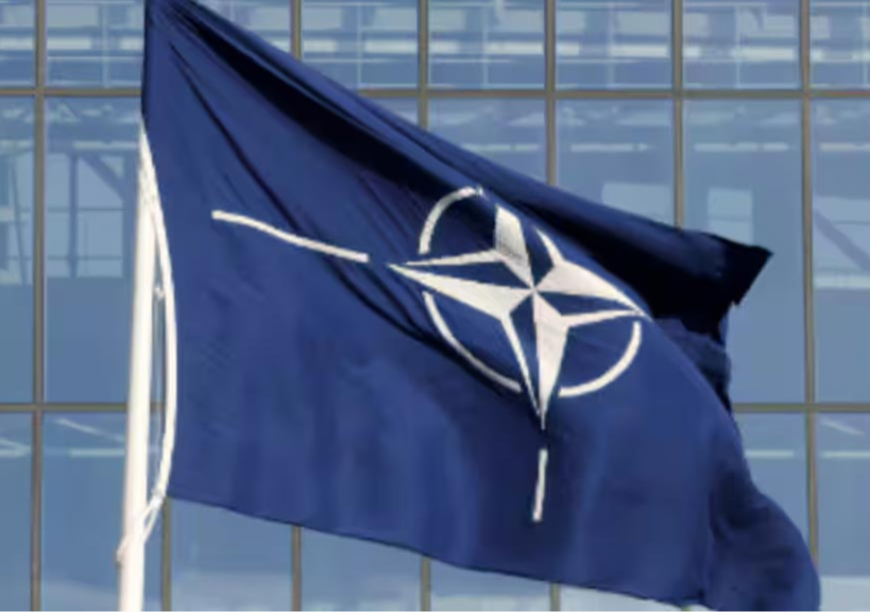-
CENTRES
Progammes & Centres
Location
When comparing the current geopolitical landscape of Europe to the circumstances in the years following NATO’s establishment, it becomes apparent that very little has changed.

As the North Atlantic Treaty Organization (NATO) marked its 75th anniversary this month, celebrations were accompanied by a sobering reality — the alliance’s raison d’être has seemingly circled back to its origins without significant alteration. Lord Ismay, NATO’s inaugural secretary-general, famously stated that the alliance was formed to “keep the Russians out, the Americans in, and the Germans down”.
Nearly three-quarters of a century later, with the exception of the German factor, the fundamental purpose outlined by Ismay remains largely unchanged. Established on April 4, 1949, in response to the “very real possibility of a Soviet invasion of Europe”, NATO finds itself once again confronting Russia as a potential threat that requires deterrence.
When comparing the current geopolitical landscape of Europe to the circumstances in the years following NATO’s establishment, it becomes apparent that very little has changed. Russia maintains a significant presence in Europe, while NATO pursues further expansion. Additionally, new alliance and partner clusters may be emerging around the world, reshaping the landscape of global security.
At worst, they can be destabilising, with impacts that reverberate widely and persist for decades. The establishment of NATO in 1949 prompted a retaliatory mutual defence treaty, the Warsaw Pact, in 1955 by the Soviet Union. Specifically, the inclusion of West Germany into NATO triggered the Soviet Union to enact a counter mutual defence treaty.
Throughout history, global crises have often served to galvanise collective security organisations, fundamentally altering their nature. NATO, initially little more than a political association, saw a significant shift in its role with the outbreak of the Korean War in 1950-53.
Its efforts to establish peace and security, first in Kosovo in 1999 and later in Afghanistan over two decades under the auspices of the United Nations, have been met with controversy and mixed results. Prior to 2014, NATO had been grappling with its purpose and struggling to revitalise its role in European security. Russia’s annexation of Crimea in 2014, followed by the ongoing conflict starting in February 2022, has spurred NATO to undergo substantial transformations.
On one hand, the Ukraine crisis has injected new vitality into NATO, with fresh commitments from its European Union (EU) members and, more significantly, a revitalised era of trans-Atlantic solidarity. On the other hand, the ongoing conflict has brought Europe closer to the brink of another world war. Amidst the prolonged war in Ukraine, one predictable deduction emerges: neither side appears prepared for negotiations.
Russia’s annexation of Crimea in 2014, followed by the ongoing conflict starting in February 2022, has spurred NATO to undergo substantial transformations.
Ukraine’s demand to restore the pre-2014 status quo seems unlikely to be accepted by Russia. Indeed, Russia may perceive an opportunity amid waning Western support and a resulting shortage of ammunition in Ukraine.
The ongoing Russia-Ukraine war has placed significant financial pressure on NATO member countries. The United States, currently NATO’s largest contributor accounting for over 65% of the organisation’s total spending in 2023 and having provided over $75 billion to Ukraine since the war began, finds itself in a structural asymmetry compared to other European treaty members.
Consequently, one of the primary objectives of the Vilnius summit of NATO held in July 2023 was for member countries to commit to spending at least 2% of their GDP on defence annually. This commitment aimed to transition from the existing asymmetrical burden-sharing model. While some progress has been made in this regard, challenges persist.
NATO faces immense challenges spanning political, financial, and security domains. Politically, NATO and Europe confront uncertainty with the upcoming US presidential elections in November. Donald Trump’s suggestions that he could swiftly end the Russia-Ukraine war and his warnings that if European NATO members don’t increase contributions, he might encourage Russia to act as it pleases regarding NATO, cast doubt on trans-Atlantic solidarity.
This stance not only jeopardises gains made by the Joe Biden administration in standing firmly behind Ukraine politically, financially, and militarily, but also threatens to disrupt trans-Atlantic unity.
NATO has undeniably proven its resilience over time, maintaining an extensive and diverse collective security alliance. Originating with 12 members, the alliance has since expanded to 32, with Finland and Sweden as its latest additions. However, expansion alone may not serve as the sole measure of the organisation’s effectiveness over time.
NATO faces immense challenges spanning political, financial, and security domains. Politically, NATO and Europe confront uncertainty with the upcoming US presidential elections in November.
The ability to navigate diverse political interests and perspectives to uphold unity and collective action, particularly in times of crisis, remains paramount.
Additionally, NATO faces challenges in adapting to new threats posed by emerging technologies, innovation, and their applications. As NATO looks toward the Indo-Pacific in the coming decade, it is inevitable that the nature of threats will extend beyond its traditional area of responsibility. The alliance must continuously evolve to address emerging security challenges, including cyber warfare, terrorism, and hybrid warfare tactics. It is NATO’s capacity to evolve and adapt in these domains that will determine whether the Western alliance can effectively sustain a competitive edge against China and other adversaries in various parts of the world.
Finally, Ukraine’s potential membership, recently hinted at by US secretary of state Antony Blinken, stands as the last and potentially most consequential move for NATO, capable of reshaping the European security landscape definitively. It holds the power to compel Russia to the negotiating table or push Europe perilously closer to the brink of nuclear conflict. As NATO grapples with these weighty decisions, its ability to navigate these challenges will define its role and impact in the global security arena for years to come.
This commentary originally appeared in Financial Express.
The views expressed above belong to the author(s). ORF research and analyses now available on Telegram! Click here to access our curated content — blogs, longforms and interviews.

Professor Harsh V. Pant is Vice President – Studies and Foreign Policy at Observer Research Foundation, New Delhi. He is a Professor of International Relations ...
Read More +
Vivek Mishra is Deputy Director – Strategic Studies Programme at the Observer Research Foundation. His work focuses on US foreign policy, domestic politics in the US, ...
Read More +